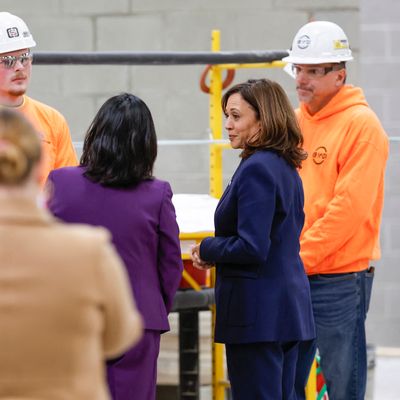
Picture: Kamil Krzacynski/AFP/Getty Photographs
Whoever wins the presidency can be inheriting an unaffordable housing market with no simple option to repair it. Years of excessive rates of interest have made it troublesome for patrons to afford a brand new house, whereas sellers are reluctant to surrender decrease month-to-month funds they locked in from an period of cheaper cash. Anybody who’s taken an informal have a look at Zillow this previous home-buying season is aware of the market is so barren of properties on the market that even unremarkable hovels are going for luxurious pricing. (It’s getting so unhealthy that, in accordance with The Wall Road Journal, practically one in ten price greater than $1 million — about double the speed simply 5 years in the past). Even when there’s unabashedly excellent news, like within the deliberate 7,000 items introduced this week for the East Bronx, there’s a catch: These items have been in dialogue since 2018 and can take no less than one other three years earlier than they’re obtainable. The influence of this yawning unaffordability is generational and lopsided — a latest spike within the generational wealth of millennials favors those that owned property, particularly those that purchased earlier than the pandemic and noticed the worth of their properties skyrocket.
On Friday, Kamala Harris proposed a repair for the market through the use of a carrot-and-stick strategy that might, basically, tilt the housing market towards youthful patrons with the least sum of money. The headline of the proposal is that she desires to construct 3 million new properties by 2029, about 50 % greater than Joe Biden had promised. This is able to be spurred by $25,000 in tax credit for first-time patrons to assist with down funds, plus tax credit for builders who make inexpensive properties.
It’s geared towards the lots of wannabe first-time patrons who seemingly don’t have any place to go, fairly than massive Wall Road traders who’ve the capital and sources to purchase up swaths of flats and act as landlords. Dwelling-builder firms like Toll Brothers and Pulte Group noticed their inventory go up on Friday, as did Zillow, and the plan has thus far gotten fairly good opinions from economists.
Harris’s plan borrows a few of Trump’s concepts, resembling tax cuts and incentives for first-time patrons. In any other case, his plans are both obscure (slicing inflation and stopping immigration), unlikely to work (opening up federal lands — a protracted and costly course of — for constructing), or of the futuristic selection {that a} Saudi prince would possibly envision (after which downsize).
What’s extra fascinating are the disincentives — that’s, the stick. These are plans that would really carry costs decrease and accomplish that extra instantly. Harris plans to chop out tax breaks for big Wall Road companies, like BlackRock and Blackstone, which have purchased up massive swaths of flats and houses all through the nation. The small print of this are spotty, but when it turns into much less worthwhile for big companies to purchase and maintain properties, the market would begin to regulate by placing extra of these properties available on the market. There’s additionally a plan to finish the already-controversial observe of algorithmic price-setting for landlords. To an extent, that is only a continuation of the Biden period, because the FBI raided a big company landlord in June, over obvious hire price-fixing. Since shelter prices, together with hire, proceed to be the single largest drag on getting inflation to come back down, this might do extra to assist affordability not only for owners, but in addition for renters.
The housing market is liable to begin altering this September. The Federal Reserve is only a month away from doubtless reducing rates of interest for the primary time since 2020, and mortgages have already turn out to be extra inexpensive. However how these decrease charges impacts house costs stays to be seen — it’s simply as doubtless that extra patrons will come to market, pushing house prices skyward. There’s nonetheless quite a bit to be decided about how Harris’s plans would work — not the least of which is how she intends to get properties in-built California or New York, the place zoning guidelines are tight. However even when she pulls that off, it’s unlikely all that constructing would change an excessive amount of nationally — final 12 months, simply over 4 million properties have been offered, the bottom quantity since 1995, whereas costs rose 1 %, the best enhance ever. What Harris must do is spur extra individuals to promote, and that isn’t solely out of her palms however the place the true threat is — particularly if too many individuals wish to promote without delay or the economic system implodes out of nowhere. To actually make housing inexpensive goes to imply strolling a advantageous line between cooling a scorching market and crashing it.



